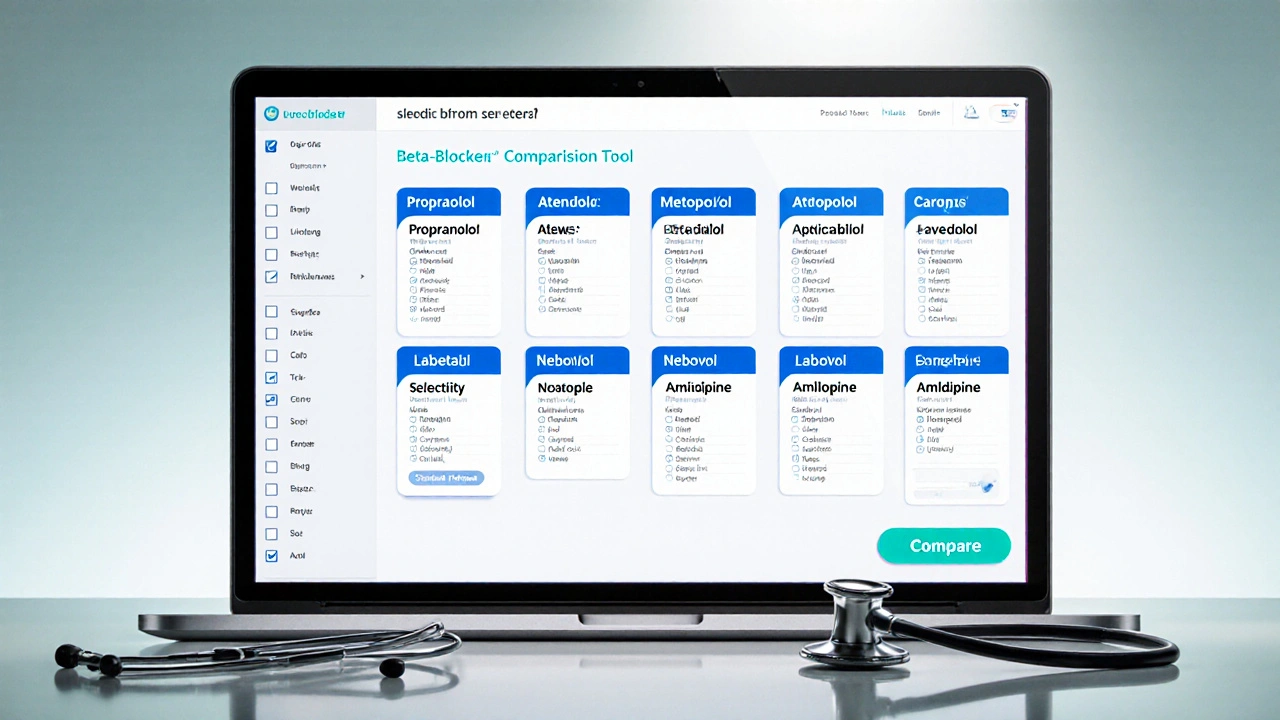Beta-Blocker Comparison Tool
If you’re trying to decide whether Propranolol is right for you, read on. This guide breaks down how propranolol stacks up against the most common alternatives, so you can match a drug to your health goals without getting lost in medical jargon.
TL;DR
- Propranolol is a non‑selective, highly lipophilic beta‑blocker useful for hypertension, anxiety, migraine prevention, and arrhythmias.
- More cardio‑selective options (atenolol, metoprolol) cause fewer respiratory side effects.
- Carvedilol and labetalol add alpha‑blocking, beneficial for heart failure.
- For patients who can’t tolerate beta‑blockers, ACE inhibitors or calcium‑channel blockers are viable substitutes.
- Choose based on selectivity, dosing convenience, comorbid conditions, and side‑effect profile.
What Is Propranolol?
Propranolol is a non‑selective beta‑adrenergic blocker that blocks both β1 and β2 receptors, reducing heart rate, contractility, and blood pressure. First approved in 1964, it remains a workhorse in cardiology and neurology because it crosses the blood‑brain barrier thanks to its high lipophilicity.
How Propranolol Works
By binding to beta receptors, propranolol blunts the effects of adrenaline and noradrenaline. This slows the heart, lowers cardiac output, and dampens the sympathetic surge that can trigger migraines or performance‑related anxiety.
When Do Doctors Prescribe Propranolol?
- Essential hypertension
- Angina pectoris
- Arrhythmias such as atrial fibrillation
- Migraine prophylaxis
- Performance anxiety and situational tremor
Key Characteristics of Propranolol
- Selectivity: Non‑selective (blocks β1 and β2)
- Lipid solubility: High - penetrates CNS, useful for anxiety but can cause insomnia
- Metabolism: Hepatic via CYP2D6; dose adjustments needed in liver disease
- Typical dose range: 40-240mg per day, divided

Common Side Effects
Because it hits β2 receptors in the lungs, propranolol can trigger bronchoconstriction - a red flag for asthma patients. Other frequent complaints include fatigue, cold hands, depressive mood, and occasional sexual dysfunction.
Alternatives to Propranolol
Below are the most frequently considered substitutes, each with its own pros and cons.
Atenolol
Atenolol is a cardio‑selective β1‑blocker, meaning it spares the lungs and is gentler on people with respiratory issues. It’s less lipophilic, so it doesn’t affect the brain as much - fewer sleep disturbances, but also less useful for anxiety.
Metoprolol
Metoprolol is another β1‑selective agent, available as an immediate‑release tablet (Lopressor) and an extended‑release version (Toprol‑XL). It’s often the first‑line choice for hypertension and post‑myocardial infarction therapy.
Carvedilol
Carvedilol blocks both β‑adrenergic and α1‑adrenergic receptors, giving it a double‑action vasodilatory effect. This makes it a top pick for heart‑failure patients, though it can cause more orthostatic dizziness.
Labetalol
Labetalol is a mixed α/β blocker that’s commonly used in acute hypertensive emergencies. Its rapid onset is useful in obstetrics, but it may provoke liver enzyme elevations.
Nebivolol
Nebivolol is a highly β1‑selective blocker with nitric‑oxide‑mediated vasodilation. It’s praised for a low incidence of sexual side effects and better metabolic profile.
Lisinopril
Lisinopril is an ACE inhibitor that lowers blood pressure by preventing angiotensin‑II formation. It’s an option when beta‑blockers are contraindicated, though cough is a common complaint.
Amlodipine
Amlodipine is a calcium‑channel blocker that relaxes vascular smooth muscle. It’s effective for hypertension and angina, with a side‑effect profile dominated by peripheral edema.
Side‑by‑Side Comparison
| Drug | Beta‑selectivity | Lipid solubility | Typical dose range | Major indications | Notable side effects |
|---|---|---|---|---|---|
| Propranolol | Non‑selective | High | 40-240mg/day | Hypertension, angina, arrhythmia, migraine, anxiety | Bronchospasm, fatigue, depression, sleep disturbance |
| Atenolol | β1‑selective | Low | 25-100mg/day | Hypertension, post‑MI | Bradycardia, cold extremities |
| Metoprolol | β1‑selective | Moderate | 50-200mg/day (IR) / 100-400mg/day (XL) | Hypertension, heart failure, post‑MI | Fatigue, dizziness, sleep issues (less than propranolol) |
| Carvedilol | β1/β2 + α1 | Moderate | 6.25-50mg twice daily | Heart failure, hypertension | Orthostatic hypotension, weight gain |
| Labetalol | β1/β2 + α1 | Low | 100-400mg twice daily (oral) | Acute hypertensive crises, pregnancy‑related HTN | Liver enzyme rise, dizziness |
| Nebivolol | Highly β1‑selective | Low‑moderate | 5-10mg/day | Hypertension, heart failure | Headache, less sexual dysfunction |
| Lisinopril | N/A (ACE‑inhibitor) | Low | 5-40mg/day | Hypertension, heart failure, post‑MI | Dry cough, hyperkalaemia, angioedema |
| Amlodipine | N/A (Calcium‑channel blocker) | Low | 2.5-10mg/day | Hypertension, chronic stable angina | Peripheral edema, gingival hyperplasia |
How to Choose the Right Drug
- Identify the primary goal. Is the focus blood‑pressure control, migraine prevention, or anxiety relief? Non‑selective agents like propranolol shine for migraines and anxiety, while β1‑selective drugs are preferred for pure cardiac work.
- Check comorbid conditions. Asthma or COPD steer you toward β1‑selective options. Diabetes patients may benefit from nebivolol’s neutral metabolic profile.
- Consider dosing convenience. Extended‑release metoprolol or once‑daily nebivolol reduce pill burden compared with multiple‑dose propranolol regimens.
- Review side‑effect tolerance. If insomnia is a deal‑breaker, avoid highly lipophilic propranolol. If peripheral edema is problematic, calcium‑channel blockers may be less suitable.
- Factor in drug interactions. Propranolol’s CYP2D6 metabolism means caution with SSRIs or certain antifungals. ACE inhibitors like lisinopril have a clean interaction profile for most patients.
Practical Tips & Common Pitfalls
- Never abruptly stop propranolol; taper over 1-2 weeks to avoid rebound tachycardia.
- Monitor blood pressure and heart rate two weeks after any dose change.
- Ask your doctor about checking liver function if you’re on carvedilol or labetalol long‑term.
- If you experience persistent cough on lisinopril, discuss switching to an ARB (e.g., losartan).
- For migraine prophylaxis, aim for at least 8 weeks at a therapeutic dose before judging efficacy.
Frequently Asked Questions
Can I use propranolol for anxiety if I have asthma?
Propranolol can worsen bronchospasm because it blocks β2 receptors in the lungs. If asthma is moderate to severe, doctors typically recommend a β1‑selective blocker like atenolol or nebivolol, or they may choose a non‑beta alternative altogether.
Why does propranolol cause vivid dreams?
Its high lipid solubility lets it cross the blood‑brain barrier, affecting central neurotransmitters that regulate sleep cycles. Switching to a less lipophilic β1‑selective agent often reduces this effect.
Is carvedilol better than metoprolol for heart failure?
Clinical trials (e.g., COPERNICUS) showed carvedilol reduces mortality more than β1‑selective blockers in severe heart‑failure patients because its α1‑blockade improves vasodilation. However, carvedilol may cause more dizziness, so patient tolerance matters.
What should I do if I develop a dry cough on lisinopril?
A dry cough is a classic ACE‑inhibitor side effect. Talk to your prescriber; they may switch you to an angiotensin‑II‑receptor blocker (ARB) such as losartan, which has a much lower cough risk.
Can beta‑blockers be taken with antidepressants?
Many antidepressants (SSRIs, SNRIs) inhibit CYP2D6, potentially raising propranolol levels. Dose adjustments and close monitoring are advisable. β1‑selective agents like metoprolol are less affected but still need oversight.



While the table does a solid job summarizing the pharmacologic profiles, it's worth noting that patient‑centered selection goes beyond numbers. For instance, a patient with migraine who also struggles with insomnia might prioritize a beta‑blocker with lower CNS penetration, like atenolol, despite propranolol’s efficacy for migraine prophylaxis. Moreover, cultural attitudes toward anxiety medication can influence adherence; some patients prefer a non‑sedating option. In practice, shared decision‑making helps align drug choice with lifestyle, comorbidities, and personal preferences. Keep an eye on how the side‑effect burden interacts with daily routines, especially for those juggling work and family responsibilities.
Your breakdown of lipid solubility nicely explains why propranolol can affect sleep patterns. From a grammatical standpoint, the list of indications is clear, yet a brief note on dose titration would enhance readability. Clinicians often start propranolol at 40 mg per day and adjust based on blood pressure response and tolerance, which distinguishes it from the once‑daily regimens of nebivolol. Additionally, mentioning the CYP2D6 interaction with certain antidepressants could prevent prescribing errors. Overall, the comparison tool is user‑friendly and could serve as a quick reference in outpatient settings.
Interestingly, the article glosses over the fact that non‑selective beta‑blockers like propranolol have historically been repurposed for covert behavioral control, a tactic seldom discussed in mainstream pharmacology. While the table lists bronchospasm as a side effect, it omits the subtle risk of masking early asthma symptoms, leading patients to underestimate respiratory decline. One could argue that the clean presentation is a deliberate downplay, steering readers toward the most marketable drugs. It's essential to scrutinize such omissions, as they shape prescribing habits and, ultimately, patient outcomes.
Great overview! 👍 The side‑effect tables are super handy, especially the bullet points for quick scanning. I love how the tool lets you compare doses side‑by‑side – makes it easy to spot that metoprolol XL cuts pill burden. Just a tip: maybe add a tooltip for the CYP2D6 note, so newbies don’t miss it. Keep up the good work! 😊